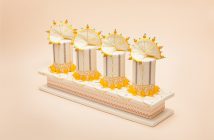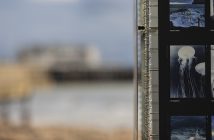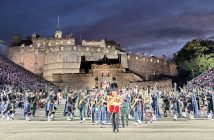He is the greatest photographer you’ve never heard of; his striking and insightful portraits of actors, artists, filmmakers and writers capture the very essence of his subjects in a way that few images can. From Jane Fonda and Samuel Beckett to Dirk Bogarde and David Hockney, these impactful photographs are at once memorable and momentous. Yet after 43 years as a photographer and despite having 52 works on permanent display at the National Portrait Gallery in London, the greatest crime of the century is that he isn’t a household name. Yet. Meet Paul Joyce.
Polymaths have a hard time of it and Paul is a case in point. His career has been a multi-talented one, enjoying great accomplishments in the fields of photography, documentary filmmaking, theatre and television directing and painting, yet he’s championed in none. Best known for his revealing and personal documentaries about filmmakers, actors and artists – from Stanley Kubrick to Robert Altman – his own works of art have taken something of a backstage position, hiding in the gloom behind the curtains of public consciousness.
“Part of my problem, looking back on my career, is that I’ve always been interested in different things; I like film, I like theatre, I’ve directed there and loved that and would still like to go back and do that again. Then there’s television, Dr Who, Play for Today, loved that too. Photography, love it. Painting, love it. So people wonder, which pigeon hole is he in? And in the end you’re not in any of them, so you’re overlooked, or you’re treated like a dilettante as if you’re not seriously committed. But in fact I’ve been seriously committed to photography since 1967, but people don’t come to talk to me about it. It’s only when Proud came along that I thought, well let’s get them out there.”
And thank heavens we have this chance to appreciate and purchase some of these previously veiled works of art, on display until 16th April at the Proud Galleries in Chelsea. Paul’s photographs are eminently outstanding; it is not just the play of light or the sitter’s natural setting, the choice of framing or the positioning of the camera. There are no extravagant poses, no eye-catching props and no facial contortions. Like the greatest works of art in any discipline, Paul’s portraits manage to capture the very life and soul of his subjects, expressing through this medium something ethereal and touching that can nevertheless be framed and mounted on a wall. The portrait is surely the greatest test of any artist and in this regard Paul’s works can be considered canonical.
The great-grand-nephew of James Joyce, Paul grew up at a time when young men had few options about their careers. “I left university and went into banking. In those days you either went into banking, insurance or the armed services. There wasn’t much choice.” But it was also an exciting time in the arts and in the film industry in particular with the re-invention of film criticism pioneered by Cahiers du Cinéma magazine in France and its UK counterpart, Movie, created by Paul Mayersberg and his peers to explore the art theory behind the medium of film. “This magazine was hugely influential on me, and I knew Mayersberg, we’d go to films together. I was about eighteen when I knew and understood the theory of the auteur, and it was something that I signed up to.”
The brooding artist in Paul wasn’t content with leading the humdrum life of a grey man and it was only a matter of time before his creative calling would come to bear. “I had done a number of jobs, and I ended up working at an estate agent. Knight Frank put me in charge of one of their departments. I was about 24, I had a decent salary, a car, and I realised that in nine months I’d clocked up around 25,000 miles. I was on the M25 one day, sat behind a huge lorry, and I had this kind of crisis – I don’t want to be doing this anymore – so I handed in my notice and gave back the car. Then I centred on the London School of Film Technique. That was my crossing the Rubicon moment.”
Paul’s first foray into filmmaking came as an inspiration after seeing a silent theatre production in London. “I had seen a short piece by Samuel Beckett called Act Without Words that was part of a Sunday evening performance at the Aldwich, which I thought would make a very good short film. I approached the cast, Fred Jones and Geoffrey Hinscliff, and they said okay, why don’t we try it? So I transposed the production from the theatre to a rubbish dump in Rainham, Essex.”
Upon completion of the film, the young Joyce was invited by John Calder, Beckett’s publisher, to show the film to the great playwright at his flat in Harley Street, an intimidating undertaking for anyone and especially a filmmaker still wet behind the ears. “It was a cavernous flat with little pools of light around and Sam sat there with a pint of Guinness and a Gauloises. This is going back to the Sixties, and even then he was a towering, mighty figure, so it was with great trepidation that I met with him. I had to set up the screen and the projector which I’d brought in my Morris Minor and had to transport up to Sam’s flat in one of those narrow iron lifts. Finally I’d got it all set up, but Sam was blind as a bat; he picked up his chair and he walked towards the screen and plonked the chair right down in front of it and I couldn’t get a full picture because his shadow was all over it. We started up, it was about 17 minutes long, and I could see his outline juddering. I thought he was angry, that he’d hit me and destroy the film, tear the screen apart. Then I looked closer, and I realised he was laughing.”
Much to Paul’s relief, Beckett remained in his chair and didn’t fly into a rage. In fact he loved the film so much that when Calder prompted him to negotiate a fee with Paul for the film rights, Sam asked if fifty pence would do it. That first adventure into filmmaking launched a career behind the camera and soon the Hollywood studios were employing Paul to shoot publicity material for their productions, exposing him to a rich world of talent that would become the subject for many of his photographs.
In 1967, having been contracted to film material for the Roger Vadim production, Barbarella starring Jane Fonda, Paul found himself on the set in Rome with the chance to test his mettle as a photographer. “That was the first time I picked up a stills camera. There was a Magnum photographer called David Hurn who was well disposed towards me, and I borrowed equipment from him and shot those first photographs. Jane cooperated and I got some great photos, and that really got me interested in photography.”
As a filmmaker and artist, Paul has photographed people with whom he shares a connection and this is a crucial aspect to the outcome of his portraits and the sitters’ relaxed and natural expressions. “My interests are wide ranging and most of the people I’ve photographed have some connection with what I love; literature or the arts, theatre, acting, painting. I try to make that connection so that we’re talking the same language. That’s why I’ve been able to make thirty films about filmmakers, and why I can get the interviews that I get out of those people, because I know what their problems are. In my own small way, I’ve struggled with the same things. I can understand what they’ve gone through on their films, running out of money, losing an actor to illness, there’s always an equivalent and they understand that.”
The black and white images that make up the bulk of his photographic work have a confidence about them that stems from an artist who is content with the medium he works in but who also enjoys what he does. The spirit of his work is to capture the reality of his subjects and as such he does not take inspiration from his peers but from the sitters themselves. “I was immediately aware that my influence wasn’t other photographers at all; there’s nothing black and white that has influenced me in any respect. But Hans Holbein’s portraits, particularly the ones in the Frick Collection in New York, of Cromwell especially – where you can see every bit of stubble on his chin – it was an absolutely crucial experience seeing that. Because I realised if you’re doing a portrait of someone, it should be like that. It’s a great test for an artist and photographer.”
Despite this personal connection with his subjects, many of his sitters have been notoriously difficult to photograph and it is testament to Paul’s character and his skill as a photographer that so many illustrious figures have agreed to let him immortalise their image. Spike Milligan was attracted by the old-fashioned brass and mahogany Gandolfi camera that Paul was using at the time and consented to an uncharacteristic close-up. “Spike was at an event at the ICA on The Mall, and I approached him as he came out. He instinctively said, “I don’t have time”, but then he saw the camera and he became intrigued.”
Samuel Beckett, already a friend of Paul’s, had to be cunningly coaxed into frame using the symbolic rubbish dump that Beckett is so famously concerned with as a backdrop to the photo. “He hated to be photographed. He was rehearsing Happy Days with Billie Whitelaw at the Royal Court Theatre in ‘79 and he’d invited me to the rehearsals. The theatre had a little yard where they used to back lorries in for scenery to be delivered, so I left the camera on a tripod outside. There was a fire escape up to the bar and I knew that he had a Guinness at lunch. So I waited until he’d had a couple of pints and then said, “Photograph?” and he protested, but I said if you come down to the yard you’ll see that it’s all set up down there. So he went down the stairs and he looked outside and saw this tip and all these bags, and he said, “Rubbish!” And I said, yes, that’s right.”
A wonderful example of Joyce putting his subjects at ease and prompting a show of genuine emotion is the photograph of Martin Sheen, whose intensity is captivating. “The intensity was the fact that we’d talked a lot about Marlon Brando, as I was making a film about him, and we talked about the scene that he did with Marlon in Apocalypse Now where his character decides to kill him, where he comes up out of the mud, and that got him into that frame of mind, which is what I wanted.”
What is perhaps most remarkable about Joyce is his skill in a number of artistic disciplines. His paintings, which are colourful and vibrant renditions of landscapes, were recently exhibited in Santa Monica in a show curated by Dennis Hopper, receiving wide acclaim from the Los Angeles art-set and the Hollywood A-list alike. His paintings now adorn the walls of Quentin Tarantino’s pad, among others.
And now you’re wondering, who is Paul Joyce? Is he a photographer, a painter, a filmmaker? Just as we do not ask, who was Da Vinci – an artist or a scientist – we should not be concerned about which category to place Paul Joyce in, which artistic taxonomy he falls under. Instead we should celebrate all his talents in their own right, significant as they are. Unseen Portraits is the first of his retrospective photography exhibitions and we dearly hope to see many more, in whatever medium he chooses to present to us. Genuine artistic accomplishment is rare and to achieve this in more than one discipline is even rarer. If ever there was an opportunity for the art collector to own a piece of creative brilliance before it becomes so unaffordable that only galleries and captains of industry can acquire it, the time is now, the place is Proud, the name is Paul Joyce.
Unseen Portraits: 1967 – 2009, from 31st March to 16th April at Proud Chelsea, 161 King’s Road, Chelsea, London SW3 5XP. Website: www.proud.co.uk.





1 Comment
just come across your exhibition text. I knew almost nothing about your career except an occasional actor interview on tele. Congratulations. It sounds like you gave had a good time.I am writing a kind of memoir and would welcome contact with you. Will you or whoever send me your email. Brenda and I retired to Banbury to help with daughter Rachel’s growing family. We are both well and survived my eightieth last year and our golden wedding this year. Both of us are still engaged in community camapaigns and activities.
Derrick